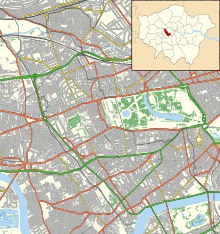Mallord Street facts for kids

|
|
| Location | Chelsea, London, England, United Kingdom |
|---|---|
| Postal code | SW3 |
| Nearest metro station | South Kensington tube station |
| Coordinates | 51°29′09″N 0°10′28″W / 51.48586°N 0.17433°W |
| Other | |
| Known for | Edwardian architecture, with several Grade II listed buildings and notable former residents |
Mallord Street is a famous street in London, England. It's located in an area called the Royal Borough of Kensington and Chelsea. The street was named after a well-known artist, J. M. W. Turner, who used to live in Chelsea. Fun fact: there are no other streets named Mallord Street anywhere else in Great Britain!
Mallord Street runs next to the King's Road. It stretches from Old Church Street all the way to The Vale. This street was created in 1909. That's when The Vale was made longer, and Mallord Street (along with Mulberry Street) was added to connect it to Old Church Street. The house numbers on the street were changed in 1924.
Many of the houses on Mallord Street are special. Nine of them are called Grade II listed buildings. This means they are important historical buildings that are protected. Lots of famous people have lived here, including the author A. A. Milne and the artist Augustus John.
Contents
Famous Residents and Buildings
Mallord Street has been home to many interesting people over the years. Let's explore some of the notable buildings and the people who lived in them.
Homes on the Odd-Numbered Side
No. 1: Artists and Musicians
No. 1 Mallord Street was built in 1911. It was designed by an architect named Ralph Knott. The first person to live there was Cecil Arthur Hunt, a watercolour artist. He decided to become a full-time painter after working as a lawyer.
Later, another British artist, Graham Petrie, lived at No. 1. He was known for his paintings and poster designs. From 1953, the famous pianist Louis Kentner lived here. He was known for playing the music of Chopin and Liszt.
No. 7: Women Who Made a Difference
At No. 7, two important women lived together. They were Enid Moberly Bell and Anne Lupton. Enid was a writer and the first headmistress of Lady Margaret School. She was also involved with the Lyceum Club for female artists and writers.
Anne Lupton was the person who started the London Housing Centre. Both women studied at Newnham College at Cambridge University. They were very active in supporting women's issues.
Nos. 9, 11, 13, and 15: A Famous Author's Home
Nos. 9, 11, 13, and 15 are a group of four houses built around 1914. They are all Grade II listed buildings.
No. 13 is very special because it has a blue plaque. This plaque tells us that it was the home of the famous author A. A. Milne (1882–1956) and his wife Daphne. They lived here from 1919 until about 1940. Their son, Christopher Robin, was born in this house. He was the inspiration for the character Christopher Robin in his father's beloved Winnie-the-Pooh stories. A. A. Milne wrote the Winnie-the-Pooh books and two books of poems in this very house!
No. 9 was the home of Sir Arthur James Irvine. He was a British lawyer and a Labour Member of Parliament (MP). An MP is a person elected to represent a group of people in the government.
No. 15 was the home of the actor Dennis Price for a few years in the late 1940s.
No. 19: The Old Telephone Exchange
No. 19 Mallord Street used to be Chelsea's telephone exchange. This is where telephone calls were connected. What it will be used for in the future is still being discussed.
Homes on the Even-Numbered Side
Nos. 2 and 4: Mallord House
Nos. 2 and 4 are known together as Mallord House. They are also Grade II listed buildings, which means they are historically important. They were designed by the same architect, Ralph Knott, who designed No. 1.
Nos. 6 and 8: Designed for a Coachman
Nos. 6 and 8 are also Grade II listed. They were designed in 1912–13 by W. D. Caröe. These houses were originally meant for the coachman of a man named Percy Morris.
No. 10: Home of an Irish Artist
No. 10 Mallord Street was the home of John Francis Kavanagh. He was an Irish sculptor and artist. He lived there from about 1936 to 1946.
No. 18: A Military Leader's Residence
Sir William Thomas Furse, a high-ranking military officer, lived at 18 Mallord Street. He was a Master-General of the Ordnance, which is an important role in the military.
No. 26: A Writer and Politician
Anthony Crossley lived with his family at 26 Mallord Street. He was a British writer, a publisher, and a Conservative politician.
No. 28: Artists and Singers
No. 28 is a house built in 1913–14. It was designed by a Dutch architect, Robert van 't Hoff, for the artist Augustus John (1878–1961) to use as his studio. It's a Grade II listed building and has a blue plaque honoring John.
In 1935, the popular singer Gracie Fields (1887–1979) bought this house.
No. 32: Another House with a Studio
No. 32 was built around 1913 for Arthur Mitchell. It included a studio at the back, designed by Charles Hall.
Images for kids
-
Chelsea's former telephone exchange is at 19 Mallord Street.





